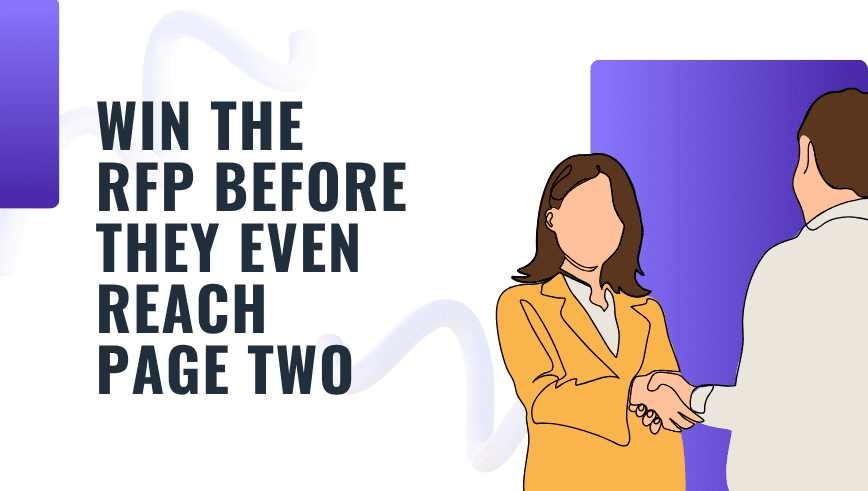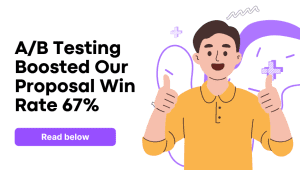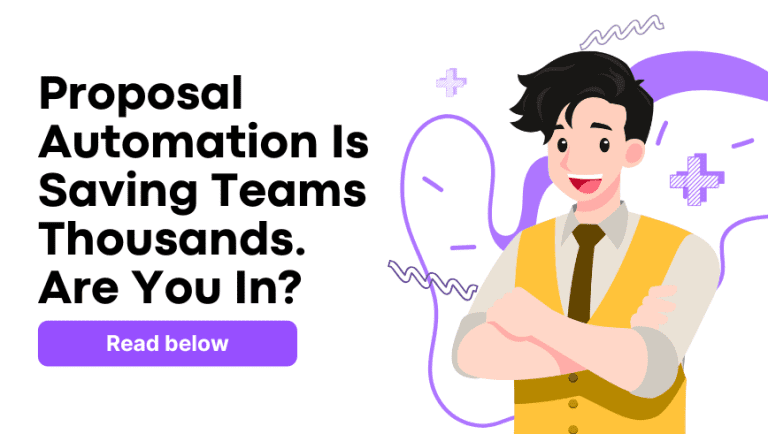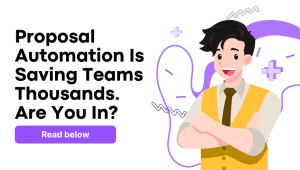C'è un momento. Proprio prima di cliccare su "Invia proposta". Quella strana, un po' di panico consapevolezza: "Abbiamo davvero iniziato con Quello lettera di presentazione?"
Ti dici che è solo una formalità. Tanto tutti scrivono la stessa cosa. "Grazie per l'opportunità... bla bla bla". Ma ecco il punto. Se fosse davvero basilare, probabilmente concluderesti più affari.
La realtà? Le lettere di presentazione per le richieste di proposta sono spesso la prima cosa che viene letta e l'ultima che viene ricordata. Non perché siano brillanti. Ma la maggior parte di esse sembra scritta da un robot educato in giacca e cravatta attillata.
Questa pagina? Definisce il tono. E in una casella di posta piena di introduzioni preconfezionate e "sinergie" forzate, la tua lettera di presentazione può essere uno sbadiglio silenzioso... o qualcosa che fa dire a qualcuno: "Ok, leggiamo il resto".
Quindi scriviamone uno che faccia il suo lavoro senza sforzarci troppo. Qualcosa che dica: "Abbiamo visto cosa ti serve. Ecco come possiamo aiutarti. E poi, siamo persone vere".
Ti mostreremo come scrivere una lettera di presentazione per una risposta a una RFP, la differenza tra una lettera di presentazione e un riepilogo esecutivo, cosa evitare, cosa conservare e come ottenere una bozza decente da ChatGPT (senza sembrare che l'abbia scritta ChatGPT).
Lettera di presentazione vs. riepilogo esecutivo: scopri la differenza
Questo fa inciampare un sacco di gente. Non preoccuparti. Anche i team di vendita più esperti confondono le cose mentre esportano freneticamente PDF alle 23:59.
Ecco come ragionare:
La tua lettera di presentazione è come presentarsi alla porta di qualcuno e dire: "Ehi, ho sentito che potresti aver bisogno di aiuto. L'abbiamo già fatto. Ecco perché ci teniamo a fare la cosa giusta per te". È breve. È personale. È il tuo primo passo.
Il tuo riepilogo esecutivo Una volta dentro, ti hanno offerto un caffè e ora stai spiegando loro come intendi risolvere il loro problema senza bruciargli la casa. È più chiaro, più dettagliato e focalizzato sul cosa e sul come. Meno sulla stretta di mano.

Il problema? La maggior parte delle persone:
- Combina entrambi in un'unica lunga passeggiata
- Utilizzare la lettera di presentazione come un archivio di informazioni
- Scrivi il riepilogo esecutivo come una vaga dichiarazione di intenti
E poi mi chiedo perché la loro proposta venga ignorata.
Inizia a pensare alla lettera di presentazione come a un controllo di atmosfera di una pagina. Dice loro: "Sì, abbiamo letto il brief. Sì, comprendiamo la posta in gioco. E no, non siamo qui per farti perdere tempo".
Il riepilogo esecutivo svolge il lavoro più impegnativo, ma solo se la lettera di presentazione della proposta apre la porta fin dall'inizio.
Perché la tua lettera di presentazione merita più impegno
La maggior parte delle lettere di presentazione per le proposte di lavoro sono una variante del tipo: "Grazie per l'opportunità di presentare la nostra proposta. Siamo molto entusiasti. La trovate in allegato".
Traduzione: Non ci abbiamo provato davvero.
Non è sbagliato. Ma è insipido... e facilmente ignorabile. Per aiutarti a evitarlo, dai un'occhiata a un esempio di lettera di presentazione per una proposta di lavoro che mostra come fare una prima impressione duratura.
Prova invece a fare così:
- Inizia con una linea che riflette l'obiettivo o il punto debole del cliente
- Menziona qualcosa di specifico dalla RFP
- Dimostra un entusiasmo genuino, non scritto
- Inizia con il modo in cui aiuterai, non con chi sei
Altri suggerimenti per la lettera di presentazione che sono davvero utili:
- Limitatevi a un massimo di 150-250 parole. Se ne scrivete di più, salteranno il testo.
- Utilizza un linguaggio naturale e chiaro. Evita riempitivi.
- Evidenzia un valore o un'intuizione unica che porti con te.
- Non ripetere il riepilogo esecutivo o la sezione Chi siamo.
- Se disponibile, indirizzarlo al team (o alla persona) indicato nella richiesta di proposta.
- Mostra il tuo tono collaborativo, affidabile o creativo, a seconda del progetto.
Errori comuni da evitare in una lettera di presentazione di una proposta
- Scrivere una nota generica che potrebbe essere inviata a qualsiasi cliente
- Spiegare eccessivamente la storia della tua azienda
- Usare un linguaggio gergale o eccessivamente formale
- Non dimostrare di aver effettivamente letto la RFP
- Rendendo tutto più incentrato su di te che su di loro
Un buon test? Se la lettera di presentazione della tua proposta non cambia molto da un cliente all'altro, non è abbastanza specifica.
Quando e dove utilizzare una lettera di presentazione per una proposta
Le lettere di presentazione non sono sempre obbligatorie, ma sono efficaci se usate correttamente. Sono particolarmente utili per:
- Richieste di proposte governative in cui il tono e il posizionamento sono importanti
- Gare competitive in cui sono coinvolti più fornitori
- Qualsiasi progetto formale in cui si desidera fare una buona prima impressione
Se una RFP include requisiti dettagliati, una lettera di presentazione ponderata dimostra rispetto per il processo e distingue la tua proposta.
Come scrivere una lettera di presentazione per la risposta a una richiesta di proposta

È qui che traduci tutto questo in una struttura. Non c'è bisogno di pensarci troppo, basta mantenerlo concentrato e intenzionale.
1. Aprirsi con le loro priorità
Fai riferimento a ciò che il cliente sta cercando di ottenere. Non solo il titolo del progetto, ma anche il Perché dietro di esso.
Esempio:
"Sappiamo che la città di Brookdale mira a creare un'esperienza digitale che migliori l'accesso della comunità e semplifichi i processi interni. Abbiamo già lavorato a questa visione con città simili e siamo entusiasti di condividere i nostri insegnamenti qui."
2. Crea un ponte verso la tua credibilità
Non ti stai limitando a presentare domanda: stai dimostrando perché ha senso.
Esempio:
"Il nostro team ha aiutato oltre 20 clienti del settore pubblico a implementare piattaforme conformi all'ADA con strumenti back-end scalabili. Il risultato? Utenti più soddisfatti, gestione dei contenuti più semplice e una maggiore adozione interna."
3. Mostra chi sei, senza vantarti
Nessuno vuole leggere un curriculum qui. Menziona il tuo stile, il tuo processo o i tuoi valori.
Esempio:
"Siamo un team collaborativo, noto per la sua capacità di semplificare gli aspetti tecnici e di agire rapidamente con uno scopo preciso. Ci concentriamo sulle partnership, non solo sui passaggi di consegne."
4. Invita il passaggio successivo
Rendi facile per loro interagire. Mantieni un tono amichevole e senza troppa pressione.
Esempio:
"Saremo lieti di incontrarvi per illustrarvi la proposta, condividere casi di studio pertinenti o rispondere a qualsiasi domanda possiate avere."
Come scrivere una lettera di presentazione per una risposta a una RFP, esempio di proposta di offerta
Supponiamo che la richiesta di proposta riguardi la riprogettazione del sito web dell'amministrazione comunale. Ecco cosa tenere a mente:
- Il tono dovrebbe essere rispettoso, non formale fine a se stesso
- Dimostra di aver compreso le esigenze dell'utente e il processo burocratico
- Dimostrare di aver lavorato in precedenza in ambienti regolamentati
Per fare un esempio:
Soggetto: Proposta per la riprogettazione del sito web della città di Brookdale – [Nome della tua azienda]
Egregio Comitato di Valutazione,
Grazie per l'opportunità di rispondere alla vostra richiesta di proposta. Sappiamo che la città di Brookdale è alla ricerca di una piattaforma digitale che soddisfi gli standard di accessibilità e rifletta i valori di apertura e servizio pubblico.
Abbiamo collaborato con clienti comunali come Rivertown e Maple Grove per riprogettare siti web che hanno migliorato la soddisfazione degli utenti, semplificato i flussi di lavoro amministrativi e ridotto i ticket di supporto del 40%. Questi progetti ci hanno insegnato l'importanza di creare strumenti che non solo funzionino, ma che vengano utilizzati.
Ci piacerebbe portare la nostra esperienza a Brookdale. Il nostro team è disponibile a condividere casi di studio o rispondere a domande in qualsiasi momento.
Cordiali saluti,
[Il tuo nome]
[Il tuo titolo]
[Nome della tua azienda]
[Dettagli di contatto]
In base a quanto appena detto: un prompt ChatGPT che funziona
Ecco un rapido suggerimento che puoi utilizzare per creare una prima bozza solida per una lettera di presentazione vincente:
Richiesta: Scrivi una lettera di presentazione di 200 parole per la risposta a una richiesta di proposta per un [tipo di progetto] per un [tipo di cliente]. Gli obiettivi del cliente includono [inserisci obiettivi]. Siamo [inserisci una breve descrizione di azienda]. Tono: caldo, chiaro e professionale. Rendilo personale e coerente con il brief. Evita riempitivi o frasi generiche.
Perché funziona:

- Ti costringe a nominare gli obiettivi in anticipo
- Lo mantiene breve e umano
- Ti fornisce un punto di partenza invece di una pagina vuota
Consiglio: esegui il prompt due volte. Usa la prima versione come struttura e la seconda come backup per le righe che ti sembrano più recenti.
Lettera di presentazione: questa pagina può davvero distinguerti
La lettera di presentazione è spesso la parte più trascurata di una proposta. Ma è anche il modo migliore per dire: "Lo capiamo. Siamo le persone giuste per questo".
Non si tratta di sembrare intelligenti. Si tratta di essere chiari, rispettosi del tempo e impossibili da ignorare. Una lettera di presentazione è fondamentale per lasciare il segno.
E se scrivere proposte migliori è nel tuo mirino, stiamo costruendo qualcosa a Proposta.biz che vorrai tenere d'occhio. Stiamo lavorando a stretto contatto con esperti di proposte, team come il tuo e veri decisori per creare strumenti di scrittura di proposte che semplifichino le parti più difficili e rendano il prodotto finale molto più efficace.
Unisciti alla nostra community di esperti per contribuire a plasmarla. Avrai accesso anticipato, risorse utili e la possibilità di contribuire a creare qualcosa che non ti faccia sentire come se stessi cavando un dente.




